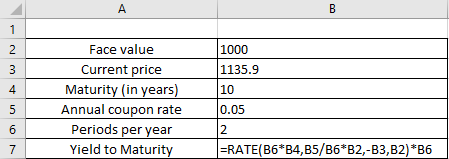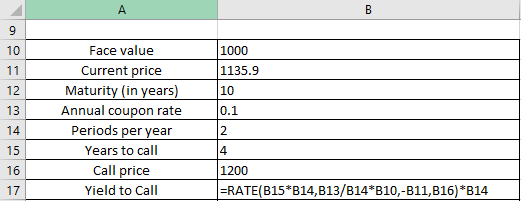Question
In: Finance
2. Davis Inc.'s bonds currently sell for $800 and have a par value of $1,000. They...
2. Davis Inc.'s bonds currently sell for $800 and have a par value of $1,000. They pay a $100 annual coupon and have a 20-year maturity, but they can be called in 5 years at $1,200. What is their Capital Gain Yield (CGY)?
3. A 10-year, 5% semiannual coupon bond selling for $1,135.90 can be called in 4 years for $1,200 (hint: par value is $1,000). What is its yield to maturity (YTM)?
4. A 10-year, 5% semiannual coupon bond selling for $1,135.90 can be called in 4 years for $1,200 (hint: par value is $1,000). What s its current yield (CY)?
5. A 10-year, 10% semiannual coupon bond selling for $1,135.90 can be called in 4 years for $1,200 (hint: par value is $1,000). What is its yield to call (YTC)?
6. Davis Inc.'s bonds currently sell for $800 and have a par value of $1,000. They pay a $100 annual coupon and have a 20-year maturity, but they can be called in 5 years at $1,200. What is their yield to maturity (YTM)?
7. Davis Inc.'s bonds currently sell for $800 and have a par value of $1,000. They pay a $60 annual coupon and have a 20-year maturity, but they can be called in 5 years at $1,200. What is their Expected Current Yield (CY)?
8. Davis Inc.'s bonds currently sell for $800 and have a par value of $1,000. They pay a $60 annual coupon and have a 20-year maturity, but they can be called in 5 years at $1,200. What is their yield to Call (YTC)?
9. Kimberly’ Motors has a beta of 1.40, the T-bill rate is 3.00%, and the Tbond rate is 7.0%. The annual return on the stock market during the past 3 years was 15.00%, but investors expect the annual future stock market return to be 10.00%. Based on the SML, what is the firm's required return?
10. Suppose the interest rate (return rate) on a 1-year T-bond is 3.0% and that on a 2-year T-bond is 6.0%. Assuming the pure expectations theory is correct, what is the market's forecast for 1-year rates 1 year from now?
11. Stacker’s Corporation's bonds have a 10-year maturity, a 10.00% semiannual coupon, and a par value of $1,000. The going interest rate (rd) is 2.00%, based on semiannual compounding. What is the bond’s price?
12. If the pure expectations theory holds, what does the market expect will be the interest rate (expected return rate) on one-year securities, three years from now? (1year maturity yield is 6.0%; 2year maturity yield is 6.1%; 3year maturity yield is 6.3%; 4year maturity yield is 6.3 %; 5year maturity yield is 6.3%)? (Hints: Draw the timeline and then calculate the interest rate (expected return rate) on two-year securities, two years from now.)
Solutions
Expert Solution
2. Capital gain yield = (call price or sale price/purchase price)1/no. of years - 1
Capital gain yield = ($1,200/$800)1/5 - 1 = 1.50.2 - 1= 1.0845 - 1 = 0.0845 or 8.45%
8.45% is annualized capital gain yield. normal capital gain yield is ($1,200/$800) - 1 = 1.5 - 1 = 0.5 or 50%.
3. Yield to maturity
| Face value | $1,000 |
| Current price | $1,135.90 |
| Maturity (in years) | 10 |
| Annual coupon rate | 5% |
| Periods per year | 2 |
| Yield to Maturity | 3.39% |
Yield to maturity calculated by formula is semi-annual. so, it is multiplied by 2 to make it annual.
Calculations

4. Current yield = annual coupon/current price = ($1,000*5%)/$1,135.90 = $50/$1,135.90 = 0.0440 or 4.40%
5. Yield to call
| Face value | $1,000 |
| Current price | $1,135.90 |
| Maturity (in years) | 10 |
| Annual coupon rate | 10% |
| Periods per year | 2 |
| Years to call | 4 |
| Call price | $1,200.00 |
| Yield to Call | 9.99% |
Yield to call calculated by formula is semi-annual. so, it is multiplied by 2 to make it annual.
Calculations

Related Solutions
A firm’s bonds currently sell for $1,180 and have a par value of $1,000. They pay a...
On July 1, 2020, Davis Corp. issued 10-year, 800 Bonds, Par Value $1,000 each, Bonds carry...
21) BrightHouse bonds currently sell for $960 each, have a par value of $1,000, 12% coupon...
Meacham Enterprises' bonds currently sell for $1,280 and have a par value of
1. Jackson Corp $1,000 par value bonds currently sell for $856.92. The coupon rate is 8%,...
Andrus Inc. issued convertible bonds at their $1,000 par value 5 years ago The bonds currently...
Ford Motor Company has bonds that currently sell for $1,140 and have a par value of...
The FIN340 Company bonds are currently trading at 101% of par (Par Value is $1,000) with...
Edgehill, Inc. has 275,000 bonds outstanding. The bonds have a par value of $1,000, a coupon...
Frusciante, Inc. has 285,000 bonds outstanding. The bonds have a par value of $1,000, a coupon...
- Consider the titration of a 20.0mL sample of 0.105M HC2H3O2 with 0.125M NaOH. Determine each of...
- Opportunity A: a "me-too" oncology drug currently in Phase 3 clinical trials that requires a $100...
- Add up the total grams of organic material extracted via 3 extractions and compare it to...
- Create a class called Cuboid in a file called cuboid.py. The constructor should take parameters that...
- 2.Some tumor suppressor genes inactivated during multi-step tumorigenesis may be readily identified because of LOH in...
- To gain approval for a new network design, upgrade, or enhancement, you will have to present...
- introduction for PH titration of vinegar
 jeff jeffy answered 2 months ago
jeff jeffy answered 2 months ago